COVER- Capital offense: Jury sends a message

Did Sarah Louise Crawford still love her estranged husband on the late November day when she died? Did she lie to her family, friends, and coworkers, telling them she was finished with an abusive relationship, when she was secretly planning a reconciliation? Did the seemingly responsible Manassas office manager decide to skip work and appointments without notice, leave her beloved cat with no food or water, and miss a date with a new suitor to instead join the man against whom she had a protective order for a spontaneous weekend getaway to Charlottesville?
Attorneys for Anthony Dale Crawford, the Manassas man charged with abducting, killing, and raping his estranged wife in November 2004, argued all those things last week.
"We don't always tell everyone everything," said Crawford's attorney Denise Lunsford, citing phone and credit card records that showed Sarah had called Crawford several times in the week leading up to her death and was still providing him with financial support. "This relationship," said Lundsford, "wasn't over."
With no eyewitnesses to Sarah's death, assistant Commonwealth's attorneys Jon Zug and Joe Platania relied solely on circumstantial evidence, hoping that the horrifying picture they painted of Sarah's last hours would persuade a jury to convict Crawford of the most egregious crime in Virginia's legal system: capital murder.
A missing daughter
When Ed Pippen found an open cell phone at the end of his Manassas driveway on Friday, November 19, he had no way of knowing he'd just discovered an integral element of a crime. He scrolled through the list of contacts saved in the phone, and called "Mom and Dad."
For Sarah's parents, who'd had dinner with their daughter at the Outback Steakhouse in Woodbridge the night before, the call from Pippin was the beginning of a nightmare. As they tried to track Sarah down, the couple learned that she hadn't shown up for work that day despite promising to deliver an important check that afternoon.
Her father, John Powers, testified that their fears intensified the next day when they discovered Sarah, 33, had missed a long-anticipated appointment at a hair salon. The couple went to Sarah's apartment to look for her, but left when they could find no sign of a disturbance. When the Powers arrived at her apartment again the next day, a Sunday morning, they saw a note and a bottle of wine from the man Sarah had been planning to go out with on Saturday evening.
"Sarah, sorry I missed you," Jeff Murphy, a contractor, had written. "Call me to let me know you're okay." Inside, Sarah's beloved cat, Sudie, was "crying," John testified.
With help from Sarah's landlord, the Powers entered the garage apartment and discovered Sudie's food and water bowls were empty. On a bedside table, Irene Powers found a book Sarah had been reading: It's My Life: Starting Over after an Abusive Relationship or Domestic Violence. It was turned, she said to page 59. According to Amazon.com, that's the first page in the chapter entitled, "Do You Still Love Him?" It comes right after the chapter entitled "The Hidden Horror: Sexual Abuse."
That Sarah was involved in an abusive relationship was no secret to her parents. Crawford, 48, had been convicted of misdemeanor assault and battery against Sarah in 1997, two years before they'd married. And in fact, on October 29, 2004– three weeks before her disappearance– the Powers had accompanied Sarah to the apartment she shared with Crawford to help her collect her belongings and move out.
Crawford called the police, who told Crawford that Sarah was within her rights to take anything that belonged to her. Manassas Police Officer Michael Carlino testified Crawford became "agitated" and began "invading her space," following Sarah around the apartment in a threatening manner. Sarah's mother testified that Crawford told Sarah, "You'll pay for this."
Though Sarah had successfully moved into her new apartment and had allegedly kept the remote location a secret from Crawford, by Sunday, November 21, three days after they'd last seen or spoken to Sarah, the Powers knew they had good reason for concern. That morning, they called Manassas police and filed a missing person report. Less than 100 miles away and a few hours later, the horror was unfolding.
A gruesome discovery
Charlottesville police were summoned to Room 118 of the Quality Inn on Emmet Street in the wee hours of Monday, November 22, 2004 to investigate an unpaid room. There were signs that troubled the manager. A "do not disturb" sign hung on the door, the television was blaring, and the air conditioning on the cool autumn night was turned up high. And there was another, more worrisome clue.
"I could smell decay," testified Charlottesville Police Officer Mike Flaherty on day two of Crawford's trial. As Flaherty and several other officers "cleared the room," he said, checking for anyone who might be hiding, they noticed a "lump" in the bed. When they pulled back the covers, they discovered the nude body of Sarah Crawford, posed on her back in a "froglike" position– knees out, ankles crossed, with her hands resting on her lower abdomen. She was dead and had been for some time, said Flaherty, describing grisly post-mortem conditions.
When officers checked a purse on a nearby table, they discovered Sarah's identity and soon learned of the previous day's missing person's report. They also learned who had checked into room 118 on Friday morning, November 19: "Dale" Crawford, Sarah's husband. Immediately a manhunt began.
With assistance from his adult daughter in South Carolina from whom Crawford had requested money, police arranged to wire it to him in Jacksonville, Florida. After being apprehended by Jacksonville police without incident on November 26– the day after Thanksgiving– Crawford dropped a bombshell.
"I know she's passed away," he said in a videotaped interview. He explained that after deciding to reconcile, the couple had gone away for the weekend, checked into the Quality Inn in Charlottesville, and then gone to breakfast at McDonald's. He'd tried to kill himself in the parking lot, he said on the tape, but Sarah had tried to stop him, and when she grabbed the gun, it accidentally went off, shooting her in the chest.
"It was basically her fault," he claimed. He said her last words were, "I love you."
However, Crawford contradicted himself several times on the tape, including saying they'd gone to breakfast before checking in to the hotel. He also admitted his wife was already mortally wounded when he placed her in the room.
"I was scared," he said of his decision not to seek medical care for her. "It disturbs me, too."
But his behavior in the days before his arrest, one witness said, was not that of a frightened man.
"He wanted to visit my family," Barbara Sullivan, his third cousin, testified for the prosecution. She hadn't seen him in "16 or 17 years," she said, when he showed up at her job near Gainesville, Florida two days after Sarah's body had been discovered in Charlottesville.
Crawford, Sullivan testified, told her he had come to Florida on vacation and had been to see nearby car races. Crawford told Sullivan the driver's side window in the car– his wife's maroon Hyundai Sonata– had been knocked out by thieves who'd stolen his wallet and belongings.
Sullivan took Crawford to see her mother, and for several hours the family reminisced about old times and ate dinner together. After dinner, Sullivan said, she took Crawford to see her sister, where the conversation turned to "different cultures, different countries." Crawford mentioned that his "soon-to-be ex-wife" was a British citizen, Sullivan said, adding that Crawford never mentioned Sarah's death.
"Ray of sunshine"
Indeed, Sarah was born in London. Irene Powers and Sarah's biological father divorced when Sarah was a baby, and her father moved away and had no further contact with the family– with the exception, her mother says, of one phone call when she was 14. (Irene says she has been unable to locate him to tell him of Sarah's death.)
Despite that rough start, Sarah "was a very happy child, a real social butterfly," Irene says. And it wasn't just the two of them for long. Irene met John Powers, a U.S. government employee living in London, before Sarah was two. Irene and John married, and John adopted the little blond girl. In 1977 the family– Irene, John, then-five-year-old Sarah and her one-year-old brother, Paul– moved from London to the United States, living first in Virginia, then in California and Texas. During those frequent moves, Sarah made friends easily. But in 1981, when Sarah was 10, the family had had enough moving around and settled in Northern Virginia.
"Sarah liked being around people; she was very outgoing, always laughing," says Irene. "She was a ray of sunshine."
While Sarah, an avid reader and animal lover, remained extroverted– she loved swimming and basketball– her interest in sports waned in her teen years, and she began struggling with her weight.
On her way to church one Sunday morning during her junior year in high school, Sarah was involved in a car accident. Although her injuries were not serious, there was a serious outcome. She fell for a rescue squad volunteer and high school drop-out who had responded to the accident. She followed him to South Carolina the next year. The marriage that began at age 19 lasted less than two years– but another unhappy relationship was on Sarah's horizon.
A history of violence
In 1992, Dale Crawford was getting his first 15 minutes of infamy. When his previous wife, Trish, accused him of spousal rape, Crawford stood trial in South Carolina. Despite a graphic video showing Crawford having sex with Trish while she was bound and blindfolded, a jury agreed with Crawford's attorney that it was a consensual marital sex game.
Crawford and his attorney, Wayne Floyd, went on CNN's Larry King Live to discuss the not-guilty verdict.
"We all talk about the wife being the victim," said Floyd. "Well, in this case, here's the victim– the man, the husband."
Because Crawford was acquitted, the Charlottesville jury wasn't allowed to hear anything about that case. But Sarah knew about it, her mother says.
"He'd been married twice before," says Irene, and her daughter at first believed Crawford's stories, that he was the victim in both relationships. "She would feel sorry for anybody," says Irene.
The parents' first impression of Crawford was not positive.
"He didn't get up off the chair, shake my hand. He couldn't look me in the eye," she recalls. "I had such a bad feeling from day one."
Irene says Crawford rarely kept a job more than a year, and that he and Sarah moved often, keeping Sarah from making good friends or from going back to school, as she frequently talked about doing.
"I did detect some unhappiness," Irene says, but Sarah "wasn't one to pour her troubles out." On one occasion, however, the Powers got a call from one of Sarah's neighbors in South Carolina telling them Sarah was at her house, hiding. "She said, 'You need to get her out of South Carolina as fast as you can; he's threatening to kill her,'" Irene recalls, adding that since she hadn't heard anything that serious from Sarah, she wondered if the neighbor was overreacting.
Whether Crawford was already threatening her or not, Sarah was beginning to take steps to change her life. While some of those changes were internal, one would become immediately apparent to anyone who saw her. While she had long struggled with obesity, during her marriage to Crawford, Irene says, her weight had ballooned to around 300 pounds.
"Deep down, she was unhappy with her life," says Irene.
In early 2002, Sarah called her mother to share some news: she was planning to undergo gastric bypass surgery. It was nearly a year before the family saw her again, when Sarah came home for Christmas in 2002.
"We almost didn't recognize her," says Irene. "She was half of what she'd been." Her parents say she lost at least 150 pounds, and although she underwent further surgery to address the loose skin that occurs after such weight loss, she was healthy enough to make another big decision: to join the Army.
"She thought it would be a good way to get an education and to be away from him, where he couldn't touch her," says Irene. "She would have been stationed in South Korea or Germany."
Sarah left for boot camp in the spring of 2003, but halfway through she injured her back and received a medical discharge. Soon after, she and Crawford moved to Northern Virginia, where he began to work at a car dealership.
"He looked like he was shaping up," Irene says. But after the dealership was sold, Crawford never worked again. Sarah, on the other hand, was doing better than ever.
A petite 5'4", Sarah was now also a slim 124 pounds. She and her mother enjoyed shopping together for the first time. "She'd never been able to wear anything," Irene recalls. "She loved Ann Taylor."
Sarah also had somewhere special to wear her new clothes: a new job.
"Mother hen," is how Mickey Stern describes Sarah, whom he hired as office manager for his Haymarket film company, Base Productions, in 2003.
Sarah was warm and giving with her colleagues, and "very responsible," Stern testified. As she and Stern got to know each other better at work, Sarah increasingly confided in him about her difficult marriage and her intention to leave Crawford.
When Sarah won a protective order against Crawford on November 1, 2004– detailing several episodes in which he allegedly battered and even sexually assaulted her– she told Stern, who offered to give her a desk in the back of the office. However, she chose to stay near the entrance. "She wanted to know if he was coming," Stern said.
Irene Powers says Sarah was like a new person after she started working for Base Productions, which shoots films, including documentaries for National Geographic and A&E network.
"She loved the people there," she says. And Stern in particular, she says, "is genuinely such a nice guy."
Concerned that Crawford had ruined Sarah's credit, and aware that she was taking the difficult step of moving out and into a place of her own, Stern allowed Sarah to use a company credit card and reimburse him later.
One expense Sarah charged: tuition at a Tennessee truck driving school for Crawford.
While Crawford's attorney Lunsford argued in court that the $1,500 charge was another sign that Sarah was still both financially and emotionally invested in the marriage, Irene Powers says the explanation was simple. Sarah just had a "heart of gold," she says, and wanted to make sure Crawford was "set up" as she moved on.
That trait, she believes, is what drew Crawford to her in the first place.
"She was more of a mother than a wife," Irene says.
Connecting the dots
What happened to Sarah between the morning of Friday, November 19, 2004 at 8:30– when her credit card shows she purchased gas in Manassas– and the time her body was discovered in Charlottesville?
Presenting nearly 100 pieces of evidence including chilling crime-scene photographs, and calling more than a dozen witnesses, assistant Commonwealth's attorneys Zug and Platania presented their theory.
They posited that a phone call Sarah made to Crawford the previous night was to arrange a meeting, but not to reconcile. Evidence and testimony showed that Sarah had prepared a document releasing her father from the lease he had co-signed on the apartment she'd shared with Crawford, and that in an effort to free her father from a connection to Crawford, she contacted her ex-husband without anyone's knowledge.
Prosecutors found evidence that Crawford had purchased a Smith & Wesson .38 caliber revolver on November 6, 2004 and that he had purchased ammunition on November 13– less than a week before Sarah died.
Defense attorneys argued that he'd been trying to sell the gun before Sarah was shot, proving he hadn't purchased it with malicious intent. The prosecution, however, suggested that the ammunition was purchased after some discussions about a potential sale.
Sarah's blood was found on the seat covers of her maroon Sonata– the car Crawford was apprehended in– and in addition to her cell phone, a box Sarah had promised to mail was found on the side of a Manassas road with her blood streaked across it.
The evidence, said Platania, suggested strongly that Crawford shot Sarah in northern Virginia and then drove to Charlottesville.
Medical examiner Deborah Kay testified that the bullet that struck Sarah in the upper right side of her chest between her breast and her armpit went through her lung and then severed her spinal cord. While Sarah could have lived "up to an hour," Kay said, she would have been paralyzed instantly.
A Quality Inn employee testified that Crawford had checked in at approximately 11:30am that Friday and that he had asked for a room on "the quiet side" of the motel.
A forensic expert testified that the odds that the semen found on Sarah's body had come from someone other than Crawford were "greater than one in six billion."
If Sarah was shot in her car in Northern Virginia and driven an hour and a half from Manassas to Charlottesville, when did intercourse take place? Why was she found naked and posed in the hotel? And could anyone reasonably believe that Sarah consented to sex with Crawford?
Guilty
For the first time in a decade, a Charlottesville jury was asked to decide a capital murder case, and a hush fell over the courtroom as the verdict was read. A little over two years ago, another Charlottesville jury found "no malice" in an 18-stab-wound streetside killing of a local firefighter. They found the killer, UVA student Andrew Alston, guilty of only involuntary manslaughter, and sentenced him to three years behind bars. On Friday, February 9, the Crawford case ended differently.
"We the jury find the defendant, Anthony Dale Crawford, guilty of the willful, deliberate, and premeditated killing of Sarah Crawford in the commission of the abduction with the intent to defile Sarah Crawford and in the commission of the rape of Sarah Crawford."
As Judge Edward Hogshire read the verdicts, a slight blush filled Crawford's face. Following the verdict, Irene and John Powers wiped tears away and hugged Zug and Platania, then hugged Charlottesville police officers and members of a group of detectives from Jacksonville, Florida, where Crawford was apprehended.
Jury foreman Jonathan Schnyer says the six men and six women were leaning toward a guilty verdict from the beginning of their deliberations, which began after closing arguments on Thursday, February 8. But with mountains of evidence and four days of testimony to review, the panel deliberated for approximately eight hours.
"It was important to me that we be thorough," Schnyer says, adding that no one piece of evidence sealed Crawford's fate. It was the cumulative effect of the prosecution's evidence that convicted him.
Crawford's videotaped interview with Jacksonville police was significant, Schnyer says, mentioning Crawford's contradictions and the fact that he "showed no remorse."
Another key piece, Schnyer says, was the "consistent clear pattern that Sarah wanted nothing to do with her husband."
Schnyer says he was "offended" by the defense team's claim that she wanted to reconcile, but he says he believes the defense attorneys "were doing the best they could with the facts." But, he adds, "The facts were not in their favor. I think it was their job to raise questions, and they did that."
Defense attorneys Rhonda Quagliana and Denise Lunsford declined comment for this story other than to release a prepared statement noting that the case presented "difficult issues for everyone."
In addition to testimony, Schnyer says the jury got a sense of Sarah's character in another way. In contrast to Crawford, who it appeared was never visited by friend or family in the spectator section, the victim's supporters were numerous.
"You could see that with all the people in the courtroom," says Schnyer. In particular, the jury noticed employer Mickey Stern's daily presence, long after his testimony was finished.
"She made a big impact on these people's lives, I think, because she'd found herself," Schnyer says. "Tragedy doesn't even describe it; it's beyond words."
The jury created a timeline as they deliberated, and soon all 12 concluded there was no question about what happened that day. But Schnyer says their conclusion was so disturbing that they agreed not to discuss the lurid details of the case with the media out of respect for Sarah's parents.
Crawford did "about the most godawful thing that one human being could do to another," he says, "and we don't want to make her parents suffer any more than they already have."
Their verdict did some talking, however. The jury found Crawford guilty of six of the seven counts, including abducting, killing, and raping her, stealing her car, and using a firearm in the commission of an abduction. The one not-guilty verdict– the use of a firearm in the commission of a rape– was perhaps an even grimmer indictment of Crawford's actions.
Zug says he understands their message.
"What they're saying very strongly is that we find, factually, that this rape occurred after she was dead."
While they took nine hours to return the verdicts, the jury took just over an hour to recommend Crawford's sentence: two consecutive life sentences plus 67 years.
One sentencing option never considered was the death penalty, and that, says Irene Powers, was at her and John's request.
"No one has a right to take anybody's life, no matter what," she says. "Two wrongs don't make a right."
Irene says she believes life in prison without possibility of parole is a "fitting punishment" for Crawford.
"I think they should put a projection of her face on his wall so he can see her every day," she says. "Getting executed would be too good for him."
Remembering Sarah
Irene Powers has started a photo collection of Sarah. "I ask everyone to send me their pictures of her," she says.
One such photo is particularly painful, but she looks at it nonetheless. It is a photo of Sarah on Christmas morning, 2003, soon after she was given a package bearing keys to a maroon Hyundai Sonata, the vehicle her parents gave her and in which she would die less than a year later.
"When those keys fell out, she jumped for joy," Irene remembers. "She was wearing tartan slippers and a red sweater, and you could see the big beam on her face."
Other photos show Sarah with her mother in Washington, D.C., at home with her father and brother, and with her cat, and the Powers' Bichon Frise, Chloe.
That the family spent extra time together in the months before Sarah's death offers some comfort to her grieving parents.
In the summer of 2003, Irene says, she flew their son Paul up from Tampa so that he and Sarah could celebrate their August birthdays together. The following spring, Sarah flew to Florida with Crawford to spend more time with her brother.
And Irene, John, and Sarah spent more time together than ever before in the months before she died.
"The three of us would go to Tyson's Corner and have a meal there," says John. "I'm grateful we insisted on doing a lot together."
Irene says Sarah was a huge fan of pop-chef Rachel Ray, and that she had planned to go to a book signing Ray was holding in Northern Virginia. Sarah had become so passionate about cooking, her parents say, she was considering culinary school.
"She'd be telling me what to do with the meat, what not to do with the meat," John laughs, recalling a backyard barbecue.
When she wasn't watching Ray's show on the Food Channel, she was reading– Nora Roberts and Patricia Cornwell were favorite authors– and she loved history. Irene says if it wasn't culinary school, she believes Sarah probably would have gone to college. "I'd helped her research some schools in Virginia," she says.
Crawford ended those dreams for Sarah– and for her parents.
"I put her in a crypt," says Irene. "I couldn't put her in the ground." Instead of the name Crawford, her parents put another name on the plaque: Sarah Louise Powers.
"She was going to go back to her maiden name," says Irene. "She was striving to be her own person."
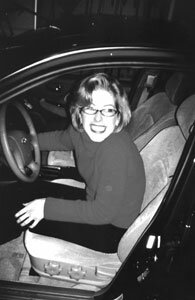
Sarah was thrilled to receive a new Hyundai Sonata for Christmas in 2003. Less than a year later, her husband killed her in that car.
PHOTO COURTESY IRENE AND JOHN POWERS
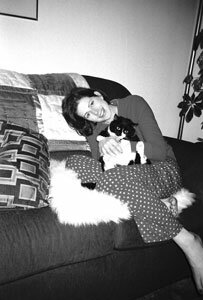
When Sarah's parents went to her apartment looking for her, they discovered her cat, Sudie (shown here with Sarah), "crying" with no food or water.
PHOTO COURTESY IRENE AND JOHN POWERS
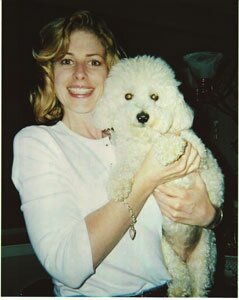
Sarah's parents won't say her name loudly in the house since their Bichon Frise, Chloe, still runs to the window looking for her.
PHOTO COURTESY IRENE AND JOHN POWERS
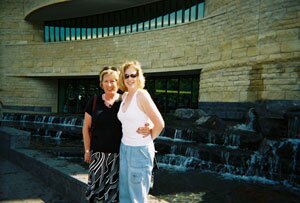
Irene and Sarah in Washington D.C.
PHOTO COURTESY IRENE AND JOHN POWERS
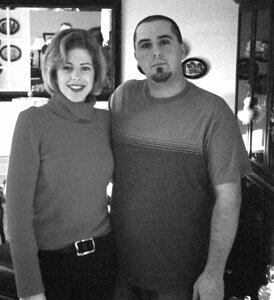
Sarah with her younger brother, Paul
PHOTO COURTESY IRENE AND JOHN POWERS
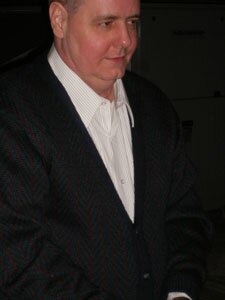
Anthony Dale Crawford enters Charlottesville Circuit Court before his conviction.
PHOTO BY WILL WALKER
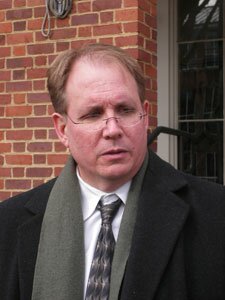
Assistant Commonwealth's attorney Jon Zug speaks outside Charlottesville Circuit Court after the verdicts are read.
PHOTO BY HAWES SPENCER
#
10 comments
This is a great story. It's good to get more perspective on who Sarah Crawford really was, although that makes me feel even angrier about what was done to her. One little knit picky thing though, the writer mispelled Rachael Ray's name.
A very well written article.
Thanks for covering something so horrific with a sense of respect. I truly applaud the jury's decision not to discuss this trial and crime. We need more citizens like this that understand their roles and responsibility as a part of the justice system.
BTW, it is fine with me if you mispell Rachael Ray's name - who the hell cares?
Wonderful coverage, written with compassion. As the mother of one of the prosecutors, I've followed this trial closely and am so happy to see a jury who was willing to mete out a just punishment for horrific crimes. After following the Andrew Alston trial, and being very disappointed with the jury's decision in that case, I truly didn't know what to expect this time around. Thank you and well done, both to the jury members and The Hook for great coverage.
You're welcome.
The thought of this man still existing makes me sick to my stomach.
I was a member of the jury in the Crawford case. Having just re-read the article some 2+ months later, I was once again impressed with how thorough it was, and what a well-rounded (and needed) portrait of Sarah it provided.
A factual correction: the "bloody box" was not found in Manassas, as the story states, but rather in Goldvein, VA, about 33 miles southwest of Manassas (and about 16 miles northwest of Fredericksburg). Based on the evidence, we concluded this was most likely where Sarah was killed--not Manassas.
In my case against Dale Crawford, the jury in SC found it hard to believe that a man could do such a thing to his wife. Even after a very graphic video of what he did to me was shown in open court the jury found him "not guilty". It is important to remember that "not guilty" does not necessarily mean "innocent." To Sarah's family - I tried to stop him before he could hurt someone else.
For his children (son and two daughters) I grieve that this crime will impact their lives forever and for generations to come. I thank God that his mother was deceased before she had to know who he really had become. To Sarah's family - God's purpose is not always clear but I believe he chose Sarah to expose the monstrosity that Dale Crawford is and to keep others safe from him.
For the first time since his crime against me in 1991 I can finally feel safe from him. God have mercy on his soul.
I was the jury foreman, and proud to due my duty with my fellow jurors. I am sorry you had to go through that but glad it can never happen again.
This is such a chilling story. In 2003 right after I graduated from college I took a job with a company that worked closely with the dealership that Dale worked for. I met him and had to deal with him on several occasions. He was not a nice person. After several dealings I asked my boss to assign someone esle to deal with him. The employee who dealt with him after me had problems with him too (sexual harassment). It makes me sick to my stomach knowing what I know now about him. I am relieved that this moster is in jail.
I am related to Mr. Crawford and new Sarah real well. She was a wonderful person and I will miss her greatly. I am sorry that it had to come to this but when drugs and alcohol consume an individual as it did Mr. Crawford eventually there is a tragic outcome. I knew Mr. Crawford when he was clean and he was an intelligent and humorous man. The "awful" side that you hear in this story was not always the case when he was clean. This is not an excuse for what he has done but I just wanted people to know that there was a "good" side to Mr. Crawford. They both will be missed dearly by me.